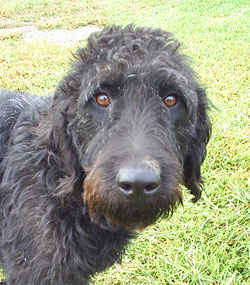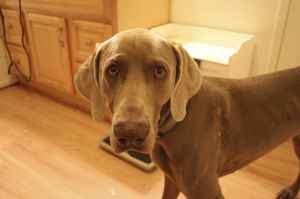More and more veterinarians are starting to recommend post operative physical therapy for cranial cruciate ligament repair patients. While opinions differ from one veterinary surgeon to another, proponents of canine PT believe that physical therapy in the post-op CCL repair dog can help bring a dog back to full function in a shorter amount of time vs. traditional rest following surgery. Veterinarians are presently conducting studies to show the efficacy of PT in animals, and to prove that it has a similar restorative mechanism as PT in humans.
There are two parts to canine physical therapy, the first covering the period immediately following surgery, and the second is begun when inflammation has subsided and there is evidence of healing. The first part of PT in the dog patient consists of icing, passive ROM (range of motion), and early wound mobilization. The goal of PT during this time is to minimize inflammation and pain, preserve joint range of motion, and to prevent or further minimize muscle and soft tissue atrophy that has already taken place.
The second part of canine PT is begun as inflammation has started to resolve, and healing begins to be the predominate theme in the wound. During this time pro-PT veterinarians believe that enough stress should be applied to healing tissues to stimulate and optimize healing without threatening the stability of the joint. Ideally, phase two activities should parallel the gradual increase in tensile strength observed in the wound. If one is too aggressive with PT during this period, failure can occur; conversely, if one lags in PTH activities, the goal of early return to function is not accomplished.
Exercises included in canine PT:
1. Sit and stand.
2. Corner stands.
3. Figure-eight walks.
4. Wheel barreling.
5. Stretching of hamstrings, quads. (without stimulation).
6. Decline treadmill followed by incline treadmill.
7. Leg weights.
8. Unbalancing activities..
Right now PT is favored in dogs with working backgrounds such as agility or hunting, but it has begun to pop up amongst other owners as well. Not all veterinary offices offer PT services, and you should check with your vet prior to CCL repair as to whether or not it is something your doctor recommends. None of these exercises should be attempted on your dog by anyone other than a trained professional, and premature movement of the joint in a post-op CCL repair dog can compromise the stability of the joint and ultimately cause the repair to fail. Always follow the direction of your veterinarian when exercising your dog during the post-operative period.


Where do you get the leg weights from?
please let me know if you found out any more about leg weights
Appreciate the info guys, thanks
After a ccl surgery (which included damage to the meniscus), how long should it take for a 2 yr. old german shepherd to walk without a limp?
It has been 5 weeks, and he still has a pronounced limp, and barely toe touches that leg to the ground.
Any one out there have this happen to a young dog?
Sherry, I am interested to see how your dog is doing? My girl had the TPLO done and was fine 8 weeks post op…she had the TTA done and is 9 weeks post op and still 3 legged….would love to know what your experience is
[…] info Physical Therapy in Post CCL Repair Dogs | Dog Knee and Leg Injury, Canine Cruciate Ligament Recover… Dog Ligament Injury– Is Surgery Really Needed? OK THIS IS THE ONE i WAS LOOKING FOR GOOD ARTICLE […]
From what I am told, the differing techniques in sugrigal options, makes a difference in how fast the dog goes beyond mere toe touching and can be seen walking limp free.
Other vairables include: the miningeal damage as with your dog, Sherry. Whether the dog has had a previous surgical repair as with your dog, Samantha. And I would include the athleticism of the dog prior to the surgery.
I’ve held the hands of frustrated friends who’s dogs have had occasional slow progress and even set backs. Do either of your vets have any helpful suggestions to help your dog push forward? Is affordable PT available in your area?
Either way, ask if there is an exercise(s), range of motion or a light stretch to allieviate the problem and speed the progress.
My vet was very clear, in addition to walking, she was to practice standing on her hind legs. He said the TTO (our proceedure) dogs need that particular strengthening as it helps keep the joint properly alligned as it gains mobility. *I have no idea of course, whether it would be helpful or even contraindicated in a CCL or TPLO. However, it wouldn’t hurt to ask. I hope you both see some progress soon. =)
Please could you let me know where to purchase leg weights from as I am having trouble finding any
Thank you
zoeadey@btinternet.com
Thanks , I’ve just been searching for info about this subject for a long time and yours is the greatest I’ve discovered till now.
However, what concerning the conclusion? Are you positive concerning the supply?
What i do not realize is in truth how you’re now not actually a lot more well-preferred than you may be now. You are so intelligent. You realize therefore significantly in the case of this topic, made me for my part believe it from a lot of varied angles. Its like men and women are not fascinated until it8?s something to accomplish with Lady gaga! Your own stuffs great. At all times maintain it up!
Gosh this is going a while back. I never had to purchase any weights. My PT lent them to me for between therapy walks trusting me to bring them back. They were color coded with removable, exchangable weights which velcroed around the leg. I suppose you could try 4 Flags Over Aspen dot com It’s where I got my sling.